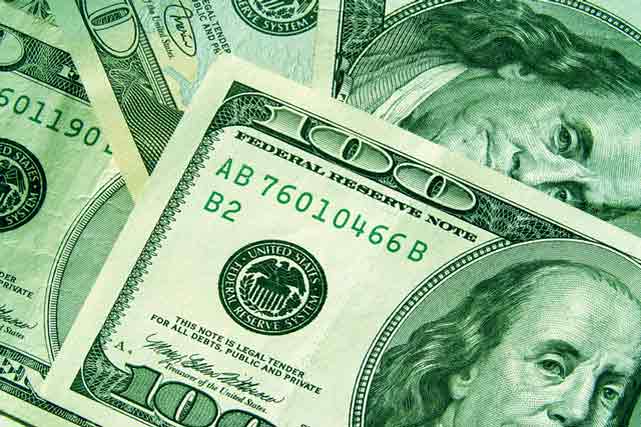Pound to Dollar Week Ahead Forecast: Near-Term GBP/USD Rangebound
- Written by
James Fuller

The Pound to Dollar exchange rate (GBP/USD) endured choppy trading through the week, supported by dollar weakness but capped by UK fiscal uncertainty.
Some analysts forecast a multi-year climb to 1.43 by 2026, while others expect the GBPUSD to stay trapped between 1.32 and 1.37 through next year.
After initial losses, RBC Capital Markets forecasts that GBP/USD will strengthen to 1.43 by the end of 2026 on dollar losses.
ING, however, has a 12-month forecast of 1.36 even with a weaker US currency.
After sliding to 10-week lows near 1.3250 during the week, GBP/USD secured a net gain to 1.3430 in choppy trading.
Risk appetite dipped late in the week on US-China fears and a slide in US banking stocks with traders also having to contend with the on-going US government shutdown while gold surged to a fresh record high as risk conditions remained a key focus.
Danske Bank commented on trade war fears; “The tariff escalation underscored two key points: first, that any renewed trade tensions under a Trump administration are unambiguously negative for the broad USD. Second, markets still view the announced measures largely as negotiation tactics rather than policy reality.”
Standard Chartered is relatively sanguine over the outlook; “We expect the US and China to reach a trade truce again as both sides have economic leverage to avoid a downward spiral.”
Rabobank noted a high degree of uncertainty over trade policy; “Whether both players have a full grasp of their own and their opponent’s tools and power(s) remains an open question.”
It also expects a radical shift in the global order which risks dramatic shifts and high volatility; “That said, it’s even harder to see the spirit going back into the bottle. In other words, the world is changing more rapidly and profoundly than many would have imagined only a few months ago.”
The debate over UK fiscal policy will continue to simmer.
According to ING; “The fiscal risks are more prevalent into the budget in November. We’re not looking for a gilt crisis, but the Chancellor is going to have to make some tough decisions on tax rises or spending cuts.”
It added; “Tighter fiscal and looser monetary policy should ultimately be a bit bearish for sterling – though GBP/USD should trade between 1.32-1.37.
According to RBC; “In the short-term, we think there is room for sterling to underperform, particularly against the USD where the strength in GBP over the last year looks overstretched.
It notes the importance of November’s budget; “Increasingly these announcements have had an FX impact, most notably in 2022. The Budget last year was poorly received by markets and sterling considerably weakened in the weeks that followed.”
RBC, however, expects a multi-year dollar downtrend which will underpin GBP/USD.
It noted; “These long-term trends are rooted in structural asset allocation shifts rather than short-term market fluctuations, reinforcing the idea that the USD’s depreciation is a multi-year process driven by fundamental factors.”
At this stage, markets are still backing very cautious Bank of England rate cuts.
In contrast, traders have fully priced in two further Fed rate cuts before the end of 2025.
Standard Chartered commented; “Over the next three to six months, we continue to expect the USD to weaken, due to a cooling U.S. labour market, slower wage growth, and a more dovish Federal Reserve stance.”
STORY LINK Pound to Dollar Week Ahead Forecast: Near-Term GBP/USD Rangebound

The Pound to Dollar exchange rate (GBP/USD) endured choppy trading through the week, supported by dollar weakness but capped by UK fiscal uncertainty.
Some analysts forecast a multi-year climb to 1.43 by 2026, while others expect the GBPUSD to stay trapped between 1.32 and 1.37 through next year.
GBP/USD Forecasts: Choppy waters
After initial losses, RBC Capital Markets forecasts that GBP/USD will strengthen to 1.43 by the end of 2026 on dollar losses.
ING, however, has a 12-month forecast of 1.36 even with a weaker US currency.
After sliding to 10-week lows near 1.3250 during the week, GBP/USD secured a net gain to 1.3430 in choppy trading.
Risk appetite dipped late in the week on US-China fears and a slide in US banking stocks with traders also having to contend with the on-going US government shutdown while gold surged to a fresh record high as risk conditions remained a key focus.
Save on Your GBP/USD Transfer
Get better rates and lower fees on your next international money transfer. Compare TorFX with top UK banks in seconds and see how much you could save.
Standard Chartered is relatively sanguine over the outlook; “We expect the US and China to reach a trade truce again as both sides have economic leverage to avoid a downward spiral.”
Rabobank noted a high degree of uncertainty over trade policy; “Whether both players have a full grasp of their own and their opponent’s tools and power(s) remains an open question.”
It also expects a radical shift in the global order which risks dramatic shifts and high volatility; “That said, it’s even harder to see the spirit going back into the bottle. In other words, the world is changing more rapidly and profoundly than many would have imagined only a few months ago.”
The debate over UK fiscal policy will continue to simmer.
According to ING; “The fiscal risks are more prevalent into the budget in November. We’re not looking for a gilt crisis, but the Chancellor is going to have to make some tough decisions on tax rises or spending cuts.”
It added; “Tighter fiscal and looser monetary policy should ultimately be a bit bearish for sterling – though GBP/USD should trade between 1.32-1.37.
According to RBC; “In the short-term, we think there is room for sterling to underperform, particularly against the USD where the strength in GBP over the last year looks overstretched.
It notes the importance of November’s budget; “Increasingly these announcements have had an FX impact, most notably in 2022. The Budget last year was poorly received by markets and sterling considerably weakened in the weeks that followed.”
RBC, however, expects a multi-year dollar downtrend which will underpin GBP/USD.
It noted; “These long-term trends are rooted in structural asset allocation shifts rather than short-term market fluctuations, reinforcing the idea that the USD’s depreciation is a multi-year process driven by fundamental factors.”
At this stage, markets are still backing very cautious Bank of England rate cuts.
In contrast, traders have fully priced in two further Fed rate cuts before the end of 2025.
Standard Chartered commented; “Over the next three to six months, we continue to expect the USD to weaken, due to a cooling U.S. labour market, slower wage growth, and a more dovish Federal Reserve stance.”
International Money Transfer? Ask our resident FX expert a money transfer question or try John's new, free, no-obligation personal service! ,where he helps every step of the way, ensuring you get the best exchange rates on your currency requirements.
TAGS: Pound Dollar Forecasts
Comments are currrently disabled
Related Stories:
- British Pound to Dollar Forecast: GBP/USD Supported as Budget Fear Fades - December 5, 2025
- GBP to USD Forecast: Pound Sterling Extends Gains Ahead of Key US Sentiment Data - December 4, 2025
- Pound-to-Dollar Forecast: GBP/USD Jumps to 5-Week Best - December 4, 2025
- Pound Sterling to Dollar Forecast: GBP/USD Rises on PMI Boost and Fed Shift - December 3, 2025
- British Pound to Dollar Forecast: GBP Steady with Fed Cut Odds Above 85% - December 3, 2025
- GBP/USD Forecast: Pound Sterling Rangebound Ahead of Key Services Data - December 2, 2025
- Pound-to-Dollar Forecast: GBP Gains Limited Amid Weak UK Backdrop - December 2, 2025
- GBP to USD Forecast: Pound Sterling Subdued as Budget Fallout Deepens - December 1, 2025
- Pound to Dollar Forecast: GBP/USD Rises but Credibility Questions Linger - December 1, 2025
Latest News:
- British Pound to Dollar Forecast: GBP/USD Supported as Budget Fear Fades - December 5, 2025
- Pound-to-Euro Forecast: GBP/EUR Jumps to 5-Week Best as Bears Back Off - December 5, 2025
- GBP to USD Forecast: Pound Sterling Extends Gains Ahead of Key US Sentiment Data - December 4, 2025
- Pound-to-Euro Dips as EUR Finds Support and Dollar Softens - December 4, 2025
- Pound-to-Dollar Forecast: GBP/USD Jumps to 5-Week Best - December 4, 2025
- British Pound to Euro Forecast: GBP Lifted, but EUR Strength to Limit Upside - December 4, 2025
- Pound Sterling to Dollar Forecast: GBP/USD Rises on PMI Boost and Fed Shift - December 3, 2025
- Pound-to-Euro Rises as Services PMI Eases Growth Fears - December 3, 2025
- British Pound to Dollar Forecast: GBP Steady with Fed Cut Odds Above 85% - December 3, 2025
- Pound-to-Euro Forecast: GBP/EUR Dips on Rising Yields, BoE Caution - December 3, 2025









